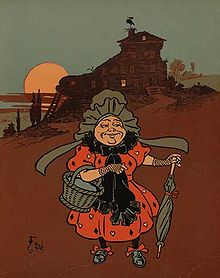There was an Old Woman Who Lived in a Shoe
There was an Old Woman Who Lived in a Shoe
| "There Was an Old Woman Who Lived in a Shoe" | |
|---|---|
 Illustration by W. W. Denslow, from a 1901 edition of Mother Goose | |
| Nursery rhyme | |
| Published | 1794 |
| Songwriter(s) | Unknown |
"There was an Old Woman Who Lived in a Shoe" is a popular English language nursery rhyme, with a Roud Folk Song Index number of 19132. Debates over its meaning and origin have largely centered on attempts to match the old woman with historical female figures who have had large families, although King George II (1683–1760) has also been proposed as the rhyme's subject.
Lyrics[edit]
The most common version of the rhyme is:[1]
The earliest printed version in Joseph Ritson's Gammer Gurton's Garland in 1794 has the coarser last line:
Many other variations were printed in the 18th and 19th centuries.[1] Marjorie Ainsworth Decker published a Christian version of the rhyme in her The Christian Mother Goose Book published in 1978:
https://en.wikipedia.org/wiki/There_was_an_Old_Woman_Who_Lived_in_a_Shoe
Comments
Post a Comment